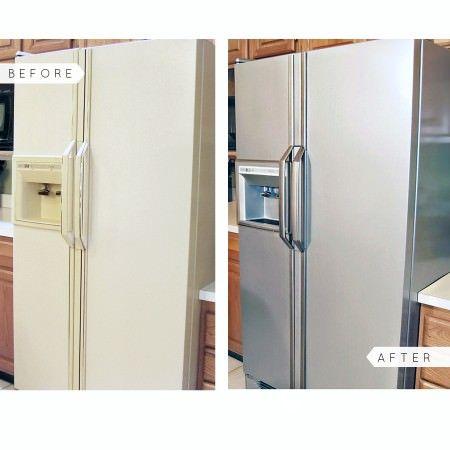Painting appliances is one of the best ways to update your kitchen without having to take on an expensive renovation. Like painting exposed bricks or a bathtub, putting on a fresh coat of appliance paint can make your hardworking machines look brand-new. But before you grab a paintbrush, here’s what you need to know.
You can achieve professional-looking results by painting your appliances yourself. However, this is not the time to use up that extra wall paint in those rusty cans in your garage. Appliance paint is specially formulated for metal surfaces and for the kind of extra-tough wear and tear to which appliances are subjected.
The type of appliance you’re painting will determine which type of appliance paint you should get.
“Appliance paint is available in heat-resistant finishes, which would work best for your appliances that get warm over an extended period of time,” according to Amy Davis, a franchise consultant for Five Star Painting.
In fact, you should use only high-heat paint on your stove, oven, or toaster—but avoid painting the actual heat coils.
“Spray paint should not be used on any surface that comes in direct contact with food, as our paint is not tested for food safety,” says Melinda Childress, product marketing manager at Sherwin-Williams.

For appliances like the refrigerator or dishwasher that can get wet, you’ll achieve the best results by choosing a moisture-resistant appliance paint.
Rust-Oleum, Krylon, and Giani are three popular household appliance paint brands. Rust-Oleum and Krylon are both available in black, white, almond, and bisque/biscuit colors. And Giani offers Liquid Stainless Steel, a DIY kit that allows you to give your boring, outdated appliances the sleek, luxurious look of stainless steel.
Davis recommends spray paints because they are easy to use on appliances.
To achieve professional-looking results, you’ll need to adhere to tried-and-true pre-painting rituals.
“A thorough cleaning will be the No.1 prep step for most appliances, since they are subject to fingerprints, grease, and food residue,” says Childress.
If the appliance is old and has traces of rust, she recommends sanding the rust to remove it before you start painting.
A lot of people try to skip the cleaning and sanding steps, but if you don’t remove grime and other residue, the paint won’t adhere to your appliances.
“You should also unplug the appliance, and remove or cover all the hardware and handles,” Davis says.
The best way to avoid a mishap is to follow the manufacturer’s instructions on the product you’re using.
To avoid inhaling paint fumes, don’t paint your appliances indoors. Instead, paint outdoors or in a well-ventilated garage.
Also, it’s best to have everything that you need on hand before you start on your project.
You’ll need the following tools and materials, according to Ami Gruenenfelder at the Giani paint company: